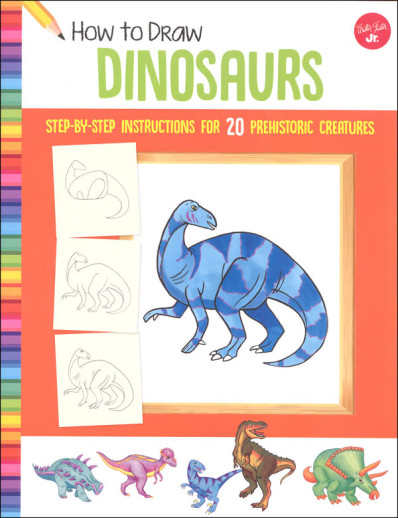We use cookies to make your experience better. To comply with the new e-Privacy directive, we need to ask for your consent to set the cookies. Learn more.
How to Draw Dinosaurs: Step-by-Step Instructions for 20 Prehistoric Creatures
With How to Draw Dinosaurs, young artists learn to bring these incredible creatures to life, guided by realistic illustrations and step-by-step instructions for 20 different dinosaur species. Fascinating facts throughout provide inspiration and learning opportunities.
The book opens with a brief description of how to get started, using basic drawing tools. Each drawing lesson begins with a basic shape and progresses, step by step, to a finished piece of artwork, making it easy to follow along. Children will be enthralled by the life-like depiction of each dinosaur accompanied by incredible facts about its weight, size, diet, and appearance.
Kids will enjoy the 32 pages of drawing instruction for a variety of dinosaurs, including:
Tyrannosaurus rex
Stegosaurus
Triceratops
Velociraptor
Pteranodon
Brachiosaurus
Iguanadon
With a mix of art instruction and fun trivia, How to Draw Dinosaurs is the perfect way for children to discover more about their favorite dinosaurs, in addition to developing their artistic talents.
By teaching little kids to notice basic shapes, they learn to build up from this foundation. For example, when they look at a cat, they notice a circle for the head, an oval for the body, triangular shapes for the ears – and then you build a tail, legs and feet as you round out the shapes. The same principle applies for dinosaurs, fish, and horses. Surprisingly, it works with machines and vehicles too! You are training the child's eye to look for basic shapes in the world around them. Instructions are in the book, but you will want some nice drawing paper for your own artwork. Maybe a blank journal would be fun to draw in as a keepsake of your early artwork! ~Sara
| Product Format: | Paperback |
|---|---|
| Brand: | Walter Foster Jr. |
| Author: | Jeff Shelly |
| Grades: | 1-3 |
| ISBN: | 9781633227583 |
| Length in Inches: | 11 |
| Width in Inches: | 8.5 |
| Height in Inches: | 0.125 |
| Weight in Pounds: | 0.25 |

